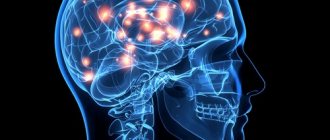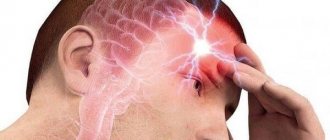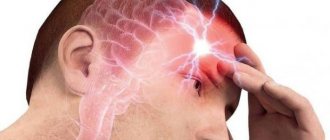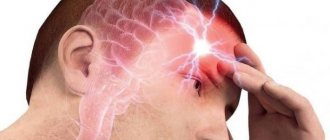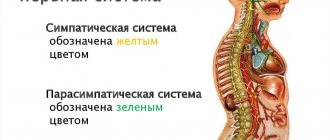Description of other types of diseases starting with the letter “T”: Toxic encephalopathy; Torsion dystonia; Traumatic encephalopathy; Peripheral nerve injuries; Transient global amnesia; Transient ischemic attack; Cavernous sinus thrombosis; Tuberculous meningitis; Brain tuberculoma; Tuberous sclerosis.
Torsion dystonia is a progressive disease of the central nervous system, which is quite rare in medical practice. The main symptom of the pathology is uncontrolled contraction of various muscle groups, leading to the development of pathological postures. As the pathological condition progresses, the patient experiences various forms of hyperkinesis (sudden involuntary movements).
Complications include joint contracture and spinal curvature. The diagnosis of torsion dystonia is made based on the exclusion of other pathologies of the central nervous system and secondary torsion dystonia. Therapy is carried out with B vitamins, antiparkinsonian drugs, antispasmodics and anticonvulsants. In case of stereotactic destruction of subcortical structures of the brain, surgical treatment is resorted to.
General information about pathology
Torsion dystonia (from the Latin “torsio” - twisting) is a chronic disease of the central nervous system, entailing tonic muscle disorders with the subsequent appearance of hyperkinesis and the formation of aphysiological postures in the patient. A pathology of this nature was first described in 1907, but given the symptoms it was classified as hysterical neurosis.
Later, in 2011, G. Oppenheim proved the organic nature of torsion dystonia, but for a long time there were numerous discussions on the nosological affiliation of the disease. The pathogenesis of torsion dystonia still remains unexplored.
The diagnosis of torsion dystonia is made to patients of any age. However, the vast majority of patients are young people under twenty years of age. 65% of the disease is diagnosed in children and adolescents under 15 years of age. Depending on the place of residence, the incidence of the pathology is 1 case per 160 thousand people or 1 per 15,000. On average, 40 cases per 100,000 population occur.
Torsion dystonia is considered a fairly pressing problem in modern medicine. This is due to the fact that the disease is becoming more common and leads to disability in young people. Moreover, today there is no truly effective pathogenetic therapy to minimize the complications of the disease.
Treatment
There are currently no medications that can prevent the development of dystonia or slow the progression. However, there are several treatment options that can relieve some of the symptoms of dystonia, so doctors can tailor each patient's treatment plan based on specific symptoms.
- Botulinum therapy. Botulinum toxin injections are often the most effective treatment for focal dystonia. Injecting small amounts of this chemical into affected muscles prevents muscle contractions and may provide temporary improvement in the abnormal postures and movements that are characteristic of dystonia. These injections were originally used to treat blepharospasm, but are now widely used to treat other major dystonias. Botulinum toxin reduces muscle spasms by blocking the release of the neurotransmitter acetylcholine, which causes muscle contraction. The effects usually begin to appear a few days after the injection and can last for several months before another injection becomes necessary.
- Drug treatment. Several classes of drugs that affect different neurotransmitters may be effective in treating various forms of dystonia. These drugs include: Anticholinergics - block the action of the neurotransmitter acetylcholine. Medicines in this group include trihexyphenidyl and benztropine. Sometimes these medications can cause side effects such as drowsiness or memory problems, especially when used in high doses and in older people. These side effects may limit their beneficial effects. Other side effects, such as dry mouth and constipation, can usually be managed with diet changes or other medications.
- GABAergic drugs that regulate the neurotransmitter GABA. These drugs include benzodiazepines such as diazepam, lorazepam, clonazepam, and baclofen. Drowsiness is a common side effect.
- Dopaminergic drugs act on the dopamine system and the neurotransmitter dopamine, which is involved in the control of muscle function. Some patients benefit from drugs that block the action of dopamine, such as tetrabenazine. Side effects (such as weight gain and involuntary and repetitive muscle movements) may limit the use of these drugs. Dopa-dependent dystonia (DDD) is a specific form of dystonia, which most often occurs in children, and is quite well treated with levodopa.
Surgical treatments may in some cases be recommended for selected patients when medications are not effective or the side effects are too severe. In some cases, with severe generalized dystonia, surgical destruction of part of the thalamus, the deep structure of the brain that controls movement, is performed. Speech impairment is the main risk of this procedure, since the thalamus is located near the brain structures that control speech. Surgical muscle denervation is sometimes helpful for focal dystonia, including blepharospasm, spasmodic dysphonia, and torticollis. But the results of such denervations are not very encouraging in the long term.
Reasons for the development of torsion dystonia
The causes and mechanism of development of torsion dystonia still remain in question. In medical practice, symptomatic and idiopathic cases of pathology are known. The only thing that can be said with certainty is the hereditary nature of torsion dystonia. There is also evidence that there are several ways of inheriting the disease: autosomal dominant and autosomal recessive. In the case of autosomal dominant inheritance of the pathology, it manifests itself at a later age and is characterized by a relatively mild course.
Symptomatic torsion dystonia is diagnosed when:
- Wilson's disease;
- cerebral palsy;
- epidemic encephalitis;
- Huntington's chorea;
- brain tumors;
- traumatic brain injuries.
There is a widespread belief among doctors that the pathology in question is a consequence of a disorder in the metabolism of dopamine in the body. This assertion is not groundless. Thus, in most cases of a confirmed diagnosis of torsion dystonia, an increased level of dopamine hydroxylase is found in the blood of patients.
Regarding the pathogenetic theory of the disease, the most common one is the one that says that the disease develops as a result of a disorder of subcortical regulation. This theory is confirmed by pronounced morphological degenerative changes in the subcortical nuclei (substantia nigra, basal ganglia, red, subthalamic).
Classification of torsion dystonia
The focal form of torsion dystonia is accompanied by tonic spasms of individual muscles. This group includes:
- Writer's cramp. In this case, the hand muscles contract involuntarily, which is why the patient has problems with writing. This also includes spasms of the foot and neck muscles.
- Oromandibular dystonia – there is an involuntary contraction of the masticatory muscles (mouth, cheeks, tongue).
- Idiopathic blepharospasm - due to the fact that a tonic spasm of the orbicularis oculi muscle occurs, the patient experiences involuntary closure of the eyelids.
- Spasmodic dysphagia - the patient complains of difficulty swallowing function or its complete absence.
- Spasmodic dysphonia - there is a tonic contraction of the vocal muscles, which is accompanied by loss of voice production function.
Other forms of torsion dystonia are:
- Hemidystonia – the muscles of half the body are affected and impaired.
- Generalized form - almost all muscle groups are subject to uncontrolled contraction.
- Segmental form of dystonia - tonic contraction is observed in several muscle groups, which are mainly located nearby.
- Multifocal – a combination of several focal forms of torsion dystonia.
Clinical picture
The first symptoms of torsion dystonia are focal spasms. They appear periodically and mainly when there is a load on the muscle group that is susceptible to the disease. For example, at an early stage of development, the writing form of pathology appears only during writing. Involuntary contractions correspond to hyperkinesis (motor acts that the patient cannot control). Such movements may have the following character:
- tonic;
- myoclonic;
- tick-shaped;
- hemiballic;
- tremor-like;
- choreatic;
- athetoid;
- myoclonic.
At the same time, hyperkinesis is less pronounced in the distal parts of the limbs than in the proximal ones. Rotational movements of the torso or limbs along the longitudinal axis are typical for pathology.
A characteristic symptom is a change in the number of involuntary acts or spastic postures. They correspond to the functional activity and body position of the patient, as well as his emotional state. Thus, while walking, the patient experiences corkscrew-like movements of the body, and when trying to perform a certain action, involuntary contraction of the muscles of the limbs.
All manifestations of torsion dystonia disappear during a period of calm, namely during sleep. Moreover, patients can adapt to their movement disorders and temporarily reduce the severity of involuntary movements. At this time, they can perform complex motor movements and fully maintain self-care.
Frequent and involuntary muscle contractions often lead to hypertrophy or prolonged spasm. In the latter case, connective tissue replacement of muscle tissue occurs, as a result of which shortening of the muscle is formed and its ability to stretch is lost. Constant and prolonged muscle spasms lead to degenerative processes that develop in the joints. Next, joint contracture is formed.
Tonic spasms of the back muscles provoke the development of the following diseases:
- scoliosis;
- rachiocampsis;
- lumbar lordosis;
- kyphoscoliosis.
At later stages of the disease, the patient's respiratory function may be impaired.
In some cases, at an early stage of development of the pathology, its local forms are noted, which over time and without proper treatment develop into a generalized form. The generalized form is accompanied by an “unusual” gait with a wide gait. Periodically, the patient's posture becomes abnormal and the person freezes in it. In some patients, isolated local manifestations persist during the disease, and the dystonic process passes without generalization. As a rule, this clinical picture is observed in patients aged 20-40 years.
EXTRAPYRAMIDAL HYPERKINESIS: SYNDROMES, NOSOLOGICAL FORMS, AREAS OF PHARMACOTHERAPY
The paper presents a classification and brief account of clinical manifestations of different extrapyramidal hyperkinesias: tremor, torsion dystonia, including paroxysmal (dyskinesia), choreic hyperkyneses, various tics, and hyperkinesias caused by the adverse effects of drugs. Emphasis is laid on the fact that extrapyramidal hyperkinesias may be displayed both by neurological diseases proper (a nosological entity) and lesions of the extrapyramidal nervous system in other diseases, as well as by the side effects of drugs. Main approaches to choosing a pharmacotherapy for different types of extrapyramidal hyperkineses are described.
Prof.
V.N. Stock Manager
Department of Neurology of the Russian Medical Academy of Postgraduate Education, Head of the Center for Extrapyramidal Diseases of the Nervous System of the Ministry of Health. Moscow Prof. VNShtok, Head, Department of Neurology, Russian Medical Academy of Postgraduate Training; Head, Center of Extrapyramidal Diseases of the Nervous System, Ministry of Health of the Russian Federation, Moscow
E
The extrapyramidal system includes the basal ganglia, the cerebellum, some parts of the motor cortex, the thalamus optic, a number of nuclear formations of the brainstem (red, reticular and substantia nigra), as well as the segmental motor apparatus of the spinal cord. The majority of the efferent impulses of the extrapyramidal system are sent through the optic thalamus (the main relay distribution “station”) to the motor cortex and then, as part of the corticospinal tract, to the motor neurons of the spinal cord (see figure). A minority of efferent impulses reach spinal motor neurons as part of the tecto-, reticulo-, rubro-, vestibulo- and olivospinal tracts (see figure). The function of the extrapyramidal system with its multineuronal loop structure is ensured by the balance of the dopaminergic, acetylcholinergic and GABAergic neurotransmitter systems. An imbalance in neurotransmitter systems due to damage to the basal ganglia by hereditary, congenital or acquired diseases is manifested, in particular, by extrapyramidal hyperkinesis. Therefore, pharmacotherapy of hyperkinesis is aimed at restoring the disturbed imbalance of neurotransmitter regulation.
Drawing. Scheme of neuronal connections of the basal ganglia and motor pathways to spinal motor neurons (according to W. Tatton et al., 1983). VA, VL, CM – thalamus nuclei; Pi and Pe – internal and external members of the globus pallidus; Sth – subthalamic nucleus; SNR – substantia nigra pars reticularis; SNс – compact part of the substantia nigra; SC – nuclei of the superior colliculus; TPC – pedunculopontine nucleus; Hab – core of the frenulum; Ret – nuclei of the reticular formation; SMA – sensorimotor area of the cortex. 1 – afferent pathways to the basal ganglia; 2 – efferent pathways from the basal ganglia; 3 – neural connections between the basal ganglia; 4 – descending tracts to spinal motor neurons.
Extrapyramidal hyperkinesis manifests itself in different clinical forms: tremor, various variants of dystonia and myoclonus.
Tremor (shaky hyperkinesis)
Tremor is a rhythmic, regular, oscillating shaking of the head, torso, limbs or parts thereof.
Physiological tremor occurs in a healthy person under the influence of emotions or physical activity. Variants of pathological tremor include: resting tremor - present in the distal parts of the extremities at rest, usually decreases with voluntary movements; postural and static-dynamic tremor, most pronounced when the trunk or limbs, respectively, take and maintain a certain position in space; intention tremor, which appears in a limb when moving in a certain direction and intensifies when approaching the target; “wing flapping” tremor is a large-amplitude tremor, predominantly expressed in the proximal muscles of the limbs.
Essential tremor
(idiopathic hereditary tremor)
is transmitted in an autosomal dominant manner and is often found in families of long-livers.
The disease can begin at 20–30 years of age. Tremor is characterized by trembling when holding a pose or objects, i.e. it is static-dynamic in nature. At rest, it manifests itself with nodding (“yes-yes”) and negative (“no-no”) head movements. It intensifies with excitement and physical stress, when taking sympathomimetic ionizing agents (coffee, tobacco), and sometimes decreases with the influence of alcohol. The disease progresses slowly, and there may be a prolonged stabilization of the severity of tremor or even a decrease in tremor for a certain period. With a long course, intention tremor and other extrapyramidal symptoms may occur. For treatment, drugs that reduce sympathetic activation are used: alpha-presynaptic receptor agonists - clonidine, beta blockers - propranolol, as well as antiepileptic drugs - primidone, phenobarbital. Rest tremor
is considered a characteristic symptom
of Parkinson's disease
(idiopathic parkinsonism) and in this case is relieved by taking antiparkinsonian drugs: anticholinergics (for example, trihexyphenidyl), amantadine, DOPA-containing drugs (levodopa, levodopa + carbidopa, levodopa + benserazide), monoamine oxidase B inhibitors (selegiline etc.), catechol-o-methyltransferase inhibitors (tolcapone, entacapone), as well as dopamine receptor agonists (peribedil, bromocriptine).
Any antiparkinsonian drug can be used as initial monotherapy, which, as the disease progresses, is usually replaced by one or another combination of these drugs. In secondary parkinsonism
(vascular toxic, postencephalitic, posttraumatic), rest tremor may be absent, mildly expressed, or combined with statokinetic or intention tremor. Especially often, different types of tremor are observed in patients with various hereditary and degenerative diseases of the nervous system, for example, with olivopontocerebellar atrophy, Huntington's chorea, hepatocerebral dystrophy (Wilson-Konovalov disease). At the same time, other symptoms of damage to the extrapyramidal system, as well as pyramidal and cerebellar symptoms, are noted. In these cases, antiparkinsonian drugs for the correction of tremor are ineffective; drugs that are used to treat essential tremor are recommended.
Dystonia
Dystonia is a type of involuntary violent movement caused by slow contraction of the muscles of the limbs, trunk, neck, and face.
Can be distal, proximal, generalized, unilateral and focal.
Damage to the putamen, the centromedian nucleus of the visual thalamus, causes torsion dystonia, spastic torticollis, and spasms of the facial muscles. When the striatum is damaged, athetosis and tonic forms of dystonia are observed. Disruption of the interaction of the caudate nucleus, putamen and motor cortex causes chorea and tics; damage to the subthalamic nucleus and its connections with the internal segment of the globus pallidus - ballism; disruption of interaction in the stem-cerebellar “triangle” (dentate nuclei of the cerebellum - red nuclei - olives of the medulla oblongata) - myoclonus. Torsion dystonia (idiopathic generalized dystonia, deforming muscular dystonia)
is transmitted in an autosomal dominant and autosomal recessive manner.
Most often begins during puberty, but later onset is also possible. In the first stages it can manifest itself in a local form - blepharospasm, or a segmental form - spastic torticollis. During the course of the disease there may be spontaneous remissions. There are two clinical variants: in the hyperkinetic-dystonic form,
the increase in plastic tone is not constant, intensifies with voluntary movements, in a standing position and when walking (especially dystonia of the trunk muscles - torsion);
dystonia improves when lying down. In the rigid-hypokinetic form,
an increase in plastic tone, which varies in individual muscle groups, leads to pathological posture settings (deforming dystonia). The second form is associated with congenital slowly progressive dystonia, combined with signs of parkinsonism and pronounced fluctuation of symptoms during the day (Segawa syndrome, juvenile dystonic parkinsonism). For the rigid-hypokinetic form, DOPA-containing drugs are used, which are especially effective in juvenile dystonic parkinsonism. For the hyperkinetic-dystonic form, the following sequence of drug administration can be recommended: 1) anticholinergics (trihexyphenidyl); 2) baclofen; 3) carbamazepine; 4) clonazepam; 5) reserpine, which depletes dopamine reserves in presynaptic depots; 6) neuroleptics – dopamine receptor blockers (haloperidol); 7) a combination of the more effective listed means. Symptomatic (acquired) torsion dystonia is usually a manifestation of cerebral palsy. Pharmacotherapeutic approaches are the same as for torsion dystonia.
Spasmodic torticollis
It is a segmental (focal) form of dystonia. There are tonic, clonic and clonic-tonic forms, and depending on the direction of head rotation - anterior, posterior and lateral forms (antero-, retro- and laterocollis). In the absence of generalization of dystonia over a number of years, spastic torticollis can be considered an independent nosological form. There is a pronounced influence of cervical-tonic reflexes on the degree of clinical manifestations. Thus, torticollis decreases or goes away when the patient is lying down, and intensifies when standing up and walking; Significant relief from corrective gestures is also characteristic - supporting (or simply touching) the head with a hand, often in a very pretentious pose. The tonic form may be accompanied by pain in the neck and shoulder girdle. Torticollis may be the result of irritation of the cervical roots of the motor spinal nerves by pathologically tortuous vessels, arachnoid adhesions, etc. (peripheral form). These pathological processes can be identified using computed tomography, magnetic resonance imaging, angiography and myelography. When choosing individually effective pharmacotherapy, the following drugs are sequentially prescribed: 1) anticholinergics; 2) baclofen; 3) carbamazepine; 4) clonazepam; 5) reserpine; 6) neuroleptics – dopamine receptor blockers. Stereotactic operations on the basal ganglia, peripheral denervation, and the injection of botulinum toxin into the affected neck muscles (usually the sternocleidomastoid muscle) are less common. When a trigger substrate for peripheral spastic torticollis is identified, surgical removal of the irritating factor is resorted to. A rare, painful atlantoaxial torticollis (Grisel syndrome) is described as an independent form, when, with congenital weakness of the capsule of the atlantoaxial joint against the background of inflammatory processes (tonsillitis, acute respiratory infections), the ligamentous apparatus of the joint relaxes, soreness of the neck muscles and rotational positioning of the head appear. X-rays reveal displacement in the area of the atlantoaxial joint. Treatment includes anti-inflammatory drugs and orthopedic correction methods.
Athetosis
It is a slow dystonic hyperkinesis, the “creeping” spread of which in the distal parts of the limbs gives the involuntary movements a worm-like character, and in the proximal ones a snake-like character. When the muscles of the limbs, trunk and face are involved, it resembles writhing. As an independent clinical form, it is described under the name “double athetosis,” which occurs when the brain is damaged in the perinatal period: infections, trauma, hypoxia, hemorrhage, intoxication, with hemolytic jaundice due to Rh incompatibility of mother and fetus. As a symptom, it is observed in hereditary diseases with damage to the extrapyramidal nervous system (torsion dystonia, Huntington's chorea, hepatocerebral dystrophy), as well as in cases of damage to the basal ganglia of various etiologies (trauma, infections, intoxication). There is no effective treatment. Attempts to use the drugs used in the treatment of torsion dystonia are justified.
Local (focal) dystonia
In most cases, local dystonia is caused by congenital insufficiency of the basal ganglia, which manifests itself only under the influence of other diseases or exogenous factors in adulthood. Symptomatic local dystonia can be caused by local irritative factors and be based on a reflex mechanism. Blepharospasm
manifested by tonic (squinting) or clonic-tonic hyperkinesis of the orbicularis oculi muscle.
The predominance of the clonic component brings its shape closer to a tic (forced blinking). As an independent nosological form of damage to the extrapyramidal system, it can have a remitting, stationary or progressive course. In other cases, it acts as the initial manifestation of generalized torsion dystonia. It may be a manifestation of damage to the nervous system during exacerbation of autoimmune diseases such as systemic lupus erythematosus, Sjogren's syndrome. In chronic eye diseases, especially those accompanied by irritation of the mucous membrane and a pain component, blepharospasm develops as a reflex form of hyperkinesis. Facial hemispasm
(Brissot's spasm) is manifested by paroxysmal clonic or clonic-tonic contraction of the muscles of half the face.
The cause of hemispasm is often irritation or compression of the facial nerve trunk by adhesions or adjacent vessels. In these cases, microsurgical decompression of the nerve is necessary; pharmacotherapy is ineffective. Facial paraspasm
(bilateral facial hemispasm, Meige syndrome, Bruegel syndrome) is an idiopathic symmetrical focal dystonia of the facial muscles, in which blepharospasm and orofacial dystonia are combined.
The severity of episodes of tonic hyperkinesis varies significantly throughout the day (and from day to day). At night the hyperkinesis goes away. Provoking factors can be a rapid change in the direction of gaze, walking, psycho-emotional stress. A connection with changes in the psyche is indicated by a depressive mood background, clinically pronounced or maneuvered (hidden) depression, manic-depressive psychosis. The manifestations of hyperkinesis and mental disorders are often in an inverse relationship: hyperkinesis appears or intensifies during remission and depression and vice versa. The sequence of prescribing medications is as follows: anticholinergics, antipsychotics, benzodiazepine drugs, among which clonazepam is somewhat more effective. Idiopathic orofacial dystonia
(OFD, synonym – orobuccofacial dystonia) is manifested by complex, predominantly choreoathetoid hyperkinesis of facial muscles and tongue.
The movements resemble chewing. Sometimes described as oromandibular dyskinesia. Unlike facial paraspasm, there is no blepharospasm with OFD. OFD noticeably increases with excitement or under the influence of other external factors. Idipathic OFD affects older people and is sometimes described as “tardive dystonia.” Unfortunately, the same name is used to describe OPD, which develops after long-term treatment (hence, also “late”) with psychotropic drugs, especially antipsychotics, as well as antiparkinsonian drugs, especially DOPA-containing ones. To avoid confusion, spontaneously occurring OPD should be defined as idiopathic, and drug-induced hyperkinesis as drug-induced OPD. Rauwalfia, benzodiazepine and GABAergic drugs are used to treat idiopathic APD. Anticholinergics are prescribed with caution in low doses, since the latter sometimes enhance OPD. Drug-induced OPD can be stopped if the rules for prescribing, taking and discontinuing psychotropic drugs are observed. Writer's cramp
is a local form of painless kinesigenic hyperkinesis (action dystonia) with damage to the extrapyramidal system.
The possibility of its occurrence due to chronic hand fatigue and psycho-emotional stress cannot be ruled out. Treatment is the same as for other forms of central dystonia. Professional spasms
of the arm muscles in musicians, typists, hairdressers, jewelers, watchmakers, as well as in athletes (tennis players, golfers, billiard players) are usually caused by tenosynovitis due to chronic overstrain of the musculo-articular system. The main difference between professional dystonia and local forms of central dystonia is the pronounced pain component that accompanies muscle spasm. It is necessary to prevent the action of factors that cause spasms. Treatment by an orthopedist and arthrologist, in addition to medications, exercise therapy, acupuncture, and physiotherapy are used.
Chorea
Choreic hyperkinesis is involuntary violent irregular movements performed at a fast pace. The pattern of choreic hyperkinesis is determined by the number of muscles of the face, trunk, and limbs participating in hyperkinesis. At the same time, these sometimes complex hyperkinesis never develop into purposeful coordinated actions, although outwardly they sometimes resemble deliberate grimaces, antics and deliberate antics.
Huntington's chorea
A progressive hereditary disease of the nervous system, transmitted in an autosomal dominant manner. It begins most often in the 4th decade of life and progresses slowly. The morphological substrate is atrophy of the frontal and parietal cortex, basal ganglia (especially the striatum). The biochemical substrate is a decrease in the level of GABA and the enzyme that synthesizes it - glutamate decarboxylase, an increase in the content of dopamine and an increase in the activity of tyrosine hydroxylase, and as the disease progresses - a decrease in the activity of cholinergic systems. Choreic hyperkinesis gradually becomes generalized and develops against the background of decreased muscle tone. As the disease progresses, dementia develops, turning into dementia-like euphoria. In the juvenile form, akinetic-rigid syndrome may come to the fore, which complicates differential diagnosis (torsion dystonia, parkinsonism, hepatocerebral dystrophy). For treatment, neuroleptics, rauwolfia preparations, D2 receptor agonists (bromocriptine) are used, and for akinetic-rigid forms and a pronounced tonic component of choroathetoid hyperkinesis, small doses of DOPA-containing agents are used. To correct depression, tricyclic antidepressants (but not monoamine oxidase inhibitors) are prescribed.
Symptomatic forms of chorea (hemichorrhea)
They are observed in various diseases accompanied by damage to the striatum: rheumatism, systemic lupus erythematosus, discirculatory encephalopathy, traumatic brain injury, encephalitis, central nervous system intoxication, during treatment with DOPA-containing drugs and antipsychotics. The following are described as independent forms: congenital chorea with damage to the subcortical nodes in the perinatal period, Sydenham's minor chorea in children as a cerebral complication of rheumatism, chorea of pregnant women in the second or third trimester (toxicosis? unrecognized rheumatism?) and senile chorea. Senile chorea occurs in old age due to discirculatory encephalopathy. The difference from Huntington's chorea is the lack of data on the hereditary nature of the disease and information about the steady, slowly progressive increase of both chorea and dementia. For the symptomatic treatment of chorea, benzodiszepine drugs (diazepam, clonazepam), valproic acid drugs, and GABAergic drugs (baclofen, picamilon) are used.
Ballism
It is a large-scale hyperkinesis involving the muscles of the arms of the proximal limbs, most often the arms. Caused by damage to the subthalamic nucleus and striatum as a result of vascular disorders, including rheumatism and systemic lupus erythematosus. It may manifest itself in the form of hemiballismus. Perphenazine (etaperazine), haloperidol, and reserpine are used for treatment.
Tiki
They represent a fast, “selective”, repeated movement in individual muscle groups as a result of brief simultaneous activation of agonists and antagonists. Motor tics, according to the structure of hyperkinesis, are divided into simple and complex, and according to localization - into generalized and focal (in the muscles of the face, head, limbs, torso). Generalized complex tics may superficially resemble a goal-directed motor act. In addition to motor ones, there are also phonic tics: simple - with elementary vocalization and complex, when the patient shouts out whole words, sometimes curses (coprolalia).
Gilles de la Tourette syndrome (disease)
(generalized tic)
A hereditary disease, transmitted in an autosomal dominant manner, most often begins at the age of 7–10 years. In the advanced form of the disease, a generalized motor tic is combined with a phonic tic, as well as psychomotor (obsessive stereotypical actions), psycho-emotional (susceptibility, anxiety, fear) and personality changes (withdrawal, shyness, self-doubt). The course of the disease is extremely variable: with periodic improvement and deterioration, with long-term remissions, with a slow progression of hyperkinesis. There are cases of spontaneous disappearance of hyperkinesis. For treatment, small doses of D2 receptor antagonists are used - antipsychotics: haloperidol, sulpiride, tiapride; agonists of presynaptic D2 receptors (bromocriptine); agonists of presynaptic a2 receptors – clonidine; in the presence of paroxysmal activity on the electroencephalogram - anticonvulsants. Symptomatic tics can be a manifestation of damage to the extrapyramidal system due to encephalitis, traumatic brain injury, dyscirculatory encephalopathy, and intoxication. The treatment is the same.
Paroxysmal forms of dystonia (dyskinesia)
These rare forms of hyperkinesis have a number of common features: hereditary nature with varying degrees of penetrance of the pathological gene; multivariate external manifestations with a frequent combination of different forms of hyperkinesis: chorea, tics, ballism, etc.; paroxysmal occurrence of hyperkinesis; the relative short duration of the episode – seconds or minutes (rarely hours); difference in the mechanism of occurrence - either without visible provoking moments, or after emotional stress or a certain physical activity, targeted action (kinesigenic forms of paroxysmal hyperkinesis). The features of the different options are reflected in their name: familial paroxysmal dystonic choreoathetosis of Mount-Rebeck (kinesigenic and non-kinesigenic forms); kinesigenic paroxysmal dyskinesia (Rülf's intentional spasm, most often observed in the hands); paroxysmal stereotypic hyperexpression (a complex involuntary psychomotor act in response to external irritation, as a rule, amnesia after passing); nocturnal paroxysmal dystonia (episodes of hyperkinesis occur during sleep - outside the phase of rapid eye movements, last from several minutes to an hour and are represented by a combination of different forms of hyperkinesis - most often choreathetosis, ballism or torsion dystonia). The so-called symptomatic paroxysmal dystonias, which occur after injuries, neuroinfections, intoxications, have with these factors, apparently, only an external, temporary connection and occur only in persons who have a hereditary or congenital predisposition in the form of a predetermined defect of the extrapyramidal nervous system. To treat paroxysmal forms of dystonia, anticonvulsants, tranquilizers and sedatives are used.
Myoclonus
They are lightning-fast involuntary contractions of individual muscles and muscle groups. The external picture of myoclonic hyperkinesis depends on the frequency, rhythm, amplitude and localization of muscle contractions. Therefore, when characterizing the clinical forms of myoclonus, they distinguish: local and generalized, unilateral or bilateral, synchronous and asynchronous, rhythmic and nonrhythmic. As mentioned above, the occurrence of myoclonus is associated with a violation of the functional interaction in the stem-cerebellar “triangle” (dentate nuclei of the cerebellum - red nuclei - olives of the medulla oblongata). Hereditary degenerative diseases, in the clinical picture of which myoclonus is the leading symptom, include: Davidenkov's familial myoclonus, Tkachev's familial localized myoclonus, Lenoble-Obino familial nystagmus-myoclonus, Friedreich's multiple paramyoclonus. Rhythmic myoclonus (myorhythmia) is described as a special local form of myoclonus, characterized by stereotypicality and rhythm. Hyperkinesis is limited to the involvement of the soft palate (velopalatine myoclonus, velopalatine “nystagmus”), individual muscles of the face, tongue, neck, and less often the limbs. The nature of myorhythmias is unclear. Most authors classify local myoclonus as symptomatic. Symptomatic forms of myoclonus occur with neuroinfections, with traumatic, toxic, dysmetabolic damage to the brain. Thus, with neuroinfections, “electric” chorea of Dubini, convulsive chorea of Morphan, posthypoxic intentional myoclonus (Lance-Adams syndrome) occur. It is possible that a necessary prerequisite for the occurrence of symptomatic myoclonus is hereditary (or congenital) insufficiency of the extrapyramidal system in the structures of the “triangle”.
Myoclonus-epilepsy
In two hereditary progressive diseases, myoclonic hyperkinesis and other cerebellar disorders are either rarely (Hunt's cerebellar myoclonic dyssynergia) or usually (Unferricht-Lundborg myoclonic epilepsy) combined with epileptic seizures. The form of seizures can be different: generalized convulsive, absence seizures. There are no effective treatments for myoclonus. Sodium valproate, clonazepam, piracetam, tiapride are used. There are isolated reports of the effectiveness of treatment with the precursor of serotonitis, 5-hydroxytryptophan. To treat diseases in which myoclonus is combined with epilepsy, anticonvulsants are used.
Drug hyperkinesis
Antiparkinsonian DOPA-containing drugs (levodopa, etc.), as well as D2-receptor agonists, in individual overdoses, cause both generalized and local dystonias, which are manifested by choreoathetoid hyperkinesis, tonic forms of dystonia in the muscles of the limbs and trunk. Local hyperkinesis in the facial muscles takes the form of orofacial dystonia, in the foot - tonic hyperkinesis, in which the outer edge of the foot deviates downward and inward, and sometimes isolated tonic extension of the big toe occurs. Any forms of these hyperkinesis decrease or disappear when the dose of DOPA-containing drugs is reduced, especially when they are discontinued. Focal dystonia can sometimes be reduced with injections of the anticholinergic drug Tremblex. Neuroleptics - often butyrophenone derivatives (haloperidol), less often phenothiazine derivatives (aminazine) - also cause extrapyramidal disorders, which are manifested either by akinetic-rigid syndrome or hyperkinesis. The latter often take the form of an OFD. If OFD appears at the beginning of treatment with antipsychotics, it is called “early”, if after months and years (or when long-term treatment with antipsychotics is discontinued) it is called “late”. Early OPD can also occur when metoclopramide is prescribed. In the case of early OPD, one antipsychotic drug should be replaced by another, and if such replacement is ineffective, treatment with antipsychotics should be discontinued. The same tactics are used when OPD occurs during long-term treatment with antipsychotics. If OPD occurs when long-term treatment with antipsychotics is suddenly discontinued, then it is advisable to resume taking the drug at the previous dose for a while, and then begin a program of slow withdrawal of the antipsychotic. Hyperkinesis when prescribed psychostimulants and antidepressants manifests itself in the form of increased aimless motor activity (akathisia), chorea, focal or segmental dystonia, erratic muscle twitching, and, less commonly, tics. To stop these side effects, psychostimulants are canceled, tranquilizers and sedatives are prescribed.
Recommended reading:
1. Badalyan L.O., Magalov Sh.M., Arkhipov B.A. and others. Clinical polymorphism of Huntington's chorea // Journal. neuropath. and a psychiatrist. – 1989. – No. 8. – pp. 49–52. 2. Golubev V.L. Facial paraspasm // Journal. neuropath. and a psychiatrist. – 1986. – No. 4. – pp. 504–509. 3. Golubev V.L. Clinical polymorphism and treatment of muscular dystonia. // Journal. neuropath. and a psychiatrist. – 1991. – No. 3. – P. 30–34. 4. Golubev V.L., Arzulanyan A.M. Facial hemispasm // Journal. neuropath. and a psychiatrist. – 1985. – No. 12. – S. 1778–1782. 5. Ivanova-Smolenskaya I.A. Questions of differential diagnostics of essential tremor // Journal. neuropath. and a psychiatrist. – 1981. – No. 3. – pp. 321–330. 6. Lees A. J. Tiki. – M.: Medicine (translated from English). – 1989. – P. 333. 7. Markova E.D. Features of the clinic, pathogenesis and treatment of torsion dystonia in childhood // Journal. neuropath. and a psychiatrist. – 1989. – No. 8. – pp. 32–34. 8. Petelin L.S. Extrapyramidal hyperkinesis. – M.: Medicine. – 1970. – 260 p. 9. Petelin L.S. Hyperkinesis (table), BME, 3rd ed., M.: Sov. encyclopedia. – 1977. – P. 434–435. 10. Smirnov A.Yu. Clinical types of Gilles de la Tourette syndrome. 11. Shtok V.N., Fedorova N.V. Diseases of the extrapyramidal nervous system (nomenclature of syndromes and nosological forms). – M.: RMAPO. – 1994. – 39 p. 12. Bruvn GW. Huntington's disease. Dyskinesias (Ed. G. W. Bruyn, et al). Sandoz, Uden. 1984;57–60. 13. Classification of extrapyramidal disorders. Proposal for international classification and glossary of terms. J Neurol Sci 1981;51(2):311–27. 14. Denislic M. Hyperkinetic movement disorders—an overview. Symposium on extrapyramidal disorders, Book of abstracts, 1994, September 8–10. Slovenia, p. 47–8. 15. Fahn S. Drug treatment of hyperkinetic movement disorders. Semin Neurol 1987;7(2):192–208. 16. Homykiewicz O. Neurochemical pathology of dyskinesias. Dyskinesias (Ed. C. W. Bruyn, et al). Sandoz. Uden 1984;39–47. 17. Jankovic J. Progressive supranuclear palsy. Symposium on extrapyramidal disorders, Book of abstracts, 1994, September 8–10, Slovenia, p. 28–30. 18. Kostic V, Dragasevic N, Stemac N, Filipovic S. Hemiballism-hemichorea syndrome: report of 30 cases. Symposium on extrapyramidal disorders, Book of abstracts, 1994. September 8–10, Slovenia, p. 50–1. 19. Lakke JPWF. Ballism. Dyskinesias (Ed. G. W. Bruyn, et al). Sandoz. Uden. 1984;125–32. 20. Marsden CD. The treatment of dyskinesias // Dyskinesias (Ed. GW Bruyn, et al). Sandoz. Uden, 1984. 21. Meirkord H. The aetiology and pathogenesis of Huntington's chorea. Symposium on extrapyramidal disorders. Book of abstracts, 1994, September 8–10, Slovenia, p. 28–30. 22. Nieuwenhuys R. Anatomy of the basal ganglia. Dvskinesias (Ed. G. W. Bruyn, et al). Sandoz, Uden, 1984;15–25. 23. Padberg G. Symptomatic chorea. Dyskinesias (Ed. G. W. Bruyn, et al). Sandoz, Uden, 1984;61–8. 24. Poungvarin N, Devahastin V. An experience of 800 patients with various movement disorders treated with Botulinum toxin A injection. Symposium on extrapyramidal disorders, Book of abstracts. 1994, September 8–10, Slovenia, p. 19–20. 25. Ross RAC, Buruma OGS. Drug induced involuntary movement and tardive dyskinesia. Dyskinesias (Ed. G. W. Bruyn, et al). Sandoz, Uden, 1984;69-81. 26. The scientific basis of the treatment of Parkinson's disease. (Ed. CM OIanow and AN Lieberman). The Parthenon Publishing Group, USA, 1992:305.
Diagnostic measures for torsion dystonia
In the neurological status, the following symptoms allow one to suspect the development of torsion dystonia:
- rigidity of certain muscle groups;
- preservation of tendon reflexes;
- no reduction in muscle strength;
- absence of sensory disorders.
The neurologist, first of all, must differentiate idiopathic torsion dystonia from secondary torsion-dystonic syndromes. Secondary syndromes, in most cases, are characterized by symptoms of damage to the nervous system, sleep disturbances, and autonomic disorders. As part of differential diagnosis, patients are referred to:
- EEG;
- Echo-EG;
- Doppler ultrasound of head vessels or REG;
- MRI or CT scan of the brain.
Torsion dystonia can be distinguished from hepatocerebral dystrophy by the fact that the patient does not have pigment deposits in the cornea. There is also no liver damage and a decrease in blood ceruloplasmin is observed. The difference with epidemic encephalitis is the absence of an acute period. A patient with torsion dystonia does not have sleep disorder, diplopia, convergence disorder, or autonomic dysfunction.
Diagnosis of the syndrome
Manifestations of dystonia overlap with symptoms of other neurological diseases. Therefore, diagnosis consists of consistently excluding all possible diseases. It is important not only to establish the form of the disease, but also to find the cause of the disease. So, if the disease is provoked by taking specific drugs, it is advisable to stop the course, but there is no need for specialized treatment.
Basic diagnostic criteria for diagnosis:
- At an appointment with a neurologist, the presence of postures or movements typical for dystonia is determined.
- A therapist or attending physician will assess the birth of the mother, collect data on the early development of the child - it is quite possible that the symptoms appeared earlier, and have specific prerequisites for the development of the disease.
- Testing for diseases associated with dystonia.
- Testing for a course of medications that may cause symptoms.
In addition to collecting anamnesis, various instrumental and laboratory studies are carried out:
- Metabolism study - copper metabolism.
- EEG is electroencephalography, which immediately allows you to exclude or confirm organic and functional pathologies of the brain.
- and MRI - prescribed in cases where other diagnostic tools were not enough.
Treatment is prescribed based on diagnostic results.
Therapy methods
When treating torsion dystonia, the same drugs are used as in the treatment of parkinsonism. We are talking about the following medications:
- combination decarboxylase inhibitor levodopa and carbidopa;
- dietazine;
- anticholinergics trihexyphenylide;
- selegiline;
- triperiden;
- centrally acting antispasmodics (diphenyltropin);
- vitamins B1 and B6;
- a-DOPA (in small quantities);
- carbamazepine, baclofen, tiapride (if hyperkinesis is pronounced).
In addition to drug treatment, patients are prescribed hydrotherapy and exercise therapy. In the secondary form of dystonia, treatment depends on the underlying cause of the disease.
In case of disability or rapid progression of the pathology, surgery is indicated, which is performed by a neurosurgeon. In this case, stereotactic combined destruction of the basal subcortical structures, namely the ventrolateral thalamic nucleus and the subthalamic zone of the brain, is indicated. If dystonia is local in nature, then it is performed contralateral to muscle disorders.
The operation for the generalized form, in most cases, is carried out in several stages. Surgery is performed first on the opposite side from where the symptoms are most severe. After 6-8 months, the operation is performed on the second side. If the severity of rigidity is symmetrical, the first stage of the operation is performed on the dominant hemisphere. In the majority of cases (80%) after surgery, there is a period of improvement in the patients' condition, which persists for a long time in 66% of cases.
Forecasts
The outcome of idiopathic torsion dystonia depends on the time of manifestation of the disease. The early onset of pathology entails a severe course. In this case, early generalization and deep disability of the patient develops. When intercurrent infections occur, the patient's death follows.
With timely surgical treatment, the prognosis is more favorable. In most cases, after surgery, rigidity and hyperkinesis disappear in patients. They retain the ability to walk, perform complex movements and care for themselves. In cases with secondary torsion dystonia, a favorable prognosis will be only if timely and effective treatment is possible. In this case, regression of spasms and hyperkinesis is noted.
Symptoms and manifestations
Children have different symptoms than adults. Thus, at an early age, parents may notice unilateral or completely asymmetrical symptoms. For example, a child turns over only on one side and completely ignores the other. Or turns his head only to one side.
In adults, the main symptom is an unnatural gait, abnormal, atypical body postures and limb positions. The disorder manifests itself mainly in skeletal muscle symptoms. Sometimes the poses are a little unusual, and sometimes they seem unnatural even at first glance.
Other symptoms:
- Impaired motor function, loss of motor skills.
- Children have delayed motor development. The child does not crawl or sit at the required age.
- With a progressive disease in adults, loss of ability to work occurs quite quickly.
- Activity and well-being largely depend on muscle tone.
In adults, dystonia can lead to disability and complete disability, especially if the cause is cerebrovascular accident.
Therefore, it is important to consult a doctor promptly. The only way to maintain your ability to work is to start treatment on time.
